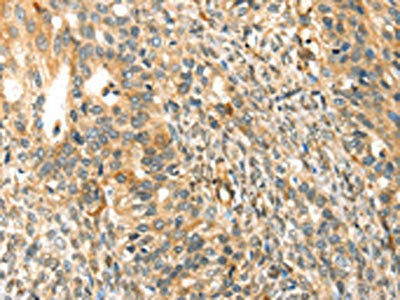Description
TRPV3 Antibody (PACO20770)
The TRPV3 Antibody (PAC020770) is a high-quality polyclonal antibody designed for research involving the TRPV3 protein. TRPV3 is a member of the TRP superfamily of ion channels and is known to play a role in various physiological processes, including thermosensation and pain perception.Raised in rabbits, this antibody is highly specific and reactive with human samples, making it suitable for a variety of applications such as Western blot and immunohistochemistry. By binding to the TRPV3 protein, researchers can accurately detect and analyze its expression in different cells and tissues, providing valuable insights into its function.
Given the involvement of TRPV3 in sensory perception and potential implications in conditions such as chronic pain and inflammatory disorders, studying this protein is essential for advancing our understanding of these processes. The TRPV3 Antibody (PAC020770) offers a reliable tool for investigating TRPV3 and its role in health and disease, making it a valuable asset for research in the fields of neuroscience, pain biology, and drug discovery.
| Antibody Name: | TRPV3 Antibody (PACO20770) |
| Antibody SKU: | PACO20770 |
| Size: | 50ul |
| Host Species: | Rabbit |
| Tested Applications: | ELISA, IHC |
| Recommended Dilutions: | ELISA:1:2000-1:5000, IHC:1:25-1:100 |
| Species Reactivity: | Human, Mouse |
| Immunogen: | Synthetic peptide of human TRPV3 |
| Form: | Liquid |
| Storage Buffer: | -20°C, pH7.4 PBS, 0.05% NaN3, 40% Glycerol |
| Purification Method: | Antigen affinity purification |
| Clonality: | Polyclonal |
| Isotype: | IgG |
| Conjugate: | Non-conjugated |
 | The image on the left is immunohistochemistry of paraffin-embedded Human breast cancer tissue using PACO20770(TRPV3 Antibody) at dilution 1/30, on the right is treated with synthetic peptide. (Original magnification: x200). |
| Background: | This gene product belongs to a family of nonselective cation channels that function in a variety of processes, including temperature sensation and vasoregulation. The thermosensitive members of this family are expressed in subsets of sensory neurons that terminate in the skin, and are activated at distinct physiological temperatures. This channel is activated at temperatures between 22 and 40 degrees C. This gene lies in close proximity to another family member gene on chromosome 17, and the two encoded proteins are thought to associate with each other to form heteromeric channels. Multiple transcript variants encoding different isoforms have been found for this gene. |
| Synonyms: | transient receptor potential cation channel, subfamily V, member 3 |
| UniProt Protein Function: | TRPV3: Putative receptor-activated non-selective calcium permeant cation channel. It is activated by innocuous (warm) temperatures and shows an increased response at noxious temperatures greater than 39 degrees Celsius. Activation exhibits an outward rectification. May associate with TRPV1 and may modulate its activity. Is a negative regulator of hair growth and cycling: TRPV3-coupled signaling suppresses keratinocyte proliferation in hair follicles and induces apoptosis and premature hair follicle regression (catagen). May form a heteromeric channel with TRPV1. Interacts with TRPV1. Abundantly expressed in CNS. Widely expressed at low levels. Detected in dorsal root ganglion. Expressed in the keratinocyte layers of the outer root sheath and, to lesser extent, to the matrix of the hair follicles. Belongs to the transient receptor (TC 1.A.4) family. TrpV subfamily. TRPV3 sub-subfamily. 3 isoforms of the human protein are produced by alternative splicing. |
| UniProt Protein Details: | Protein type:Membrane protein, multi-pass; Channel, cation; Membrane protein, integral Chromosomal Location of Human Ortholog: 17p13.2 Cellular Component: plasma membrane; integral to membrane; receptor complex Molecular Function:calcium channel activity Biological Process: negative regulation of hair cycle; response to heat; transmembrane transport Disease: Palmoplantar Keratoderma, Mutilating, With Periorificial Keratotic Plaques; Palmoplantar Keratoderma, Nonepidermolytic, Focal 2 |
| NCBI Summary: | This gene product belongs to a family of nonselective cation channels that function in a variety of processes, including temperature sensation and vasoregulation. The thermosensitive members of this family are expressed in subsets of sensory neurons that terminate in the skin, and are activated at distinct physiological temperatures. This channel is activated at temperatures between 22 and 40 degrees C. This gene lies in close proximity to another family member gene on chromosome 17, and the two encoded proteins are thought to associate with each other to form heteromeric channels. Multiple transcript variants encoding different isoforms have been found for this gene. [provided by RefSeq, Apr 2012] |
| UniProt Code: | Q8NET8 |
| NCBI GenInfo Identifier: | 62901456 |
| NCBI Gene ID: | 162514 |
| NCBI Accession: | Q8NET8.2 |
| UniProt Secondary Accession: | Q8NET8,Q8NDW7, Q8NET9, Q8NFH2, |
| UniProt Related Accession: | Q8NET8 |
| Molecular Weight: | 87,661 Da |
| NCBI Full Name: | Transient receptor potential cation channel subfamily V member 3 |
| NCBI Synonym Full Names: | transient receptor potential cation channel, subfamily V, member 3 |
| NCBI Official Symbol: | TRPV3 |
| NCBI Official Synonym Symbols: | OLMS; VRL3 |
| NCBI Protein Information: | transient receptor potential cation channel subfamily V member 3; VRL-3; vanilloid receptor-like 3; vanilloid receptor-related osmotically activated channel protein |
| UniProt Protein Name: | Transient receptor potential cation channel subfamily V member 3 |
| UniProt Synonym Protein Names: | Vanilloid receptor-like 3; VRL-3 |
| Protein Family: | Transient receptor potential cation channel subfamily |
| UniProt Gene Name: | TRPV3 |
| UniProt Entry Name: | TRPV3_HUMAN |










